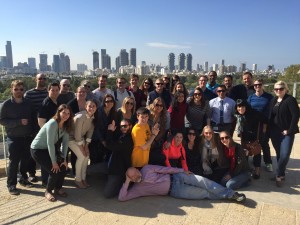On the beginning of day seven of our trip (our last day!!), we visited the Rabin Center museum. This museum commemorates the life and career of late Prime Minister Yitzhak Rabin through telling the story of Israeli history. And the view from the Center over Tel Aviv (pictured below) cannot be beat!
Student William Nash shares his personal reaction to the Rabin museum:
“We began our last day in Israel by visiting the Rabin Center Museum in Tel Aviv. It was a nice morning—warm, with an easy, steady breeze. Standing out on the balcony, we overlooked the  Tel Aviv skyline beaming just beneath the prominence of the late-morning Mediterranean sun. It was a picture of peace. But at the time I didn’t appreciate the profound character and meaning of the ambiance. To me, it was a reprieve from constant bustle of the trip. And it was the perfect opportunity to take some last-minute pictures.
Tel Aviv skyline beaming just beneath the prominence of the late-morning Mediterranean sun. It was a picture of peace. But at the time I didn’t appreciate the profound character and meaning of the ambiance. To me, it was a reprieve from constant bustle of the trip. And it was the perfect opportunity to take some last-minute pictures.
“I knew three things about Yitzhak Rabin walking into the museum. One: He was once a great Israeli prime minister. Any respectable Jeopardy enthusiast knows that. I’ll take World Leaders for $200, Alec. Two: I knew he famously shook hands with Yasser Arafat on the White House lawn to commemorate the Declaration of Principles. Make it a true Daily Double. What are the Oslo Peace Accords, Alec? Finally, I knew that he was infamously assassinated in 1995.
“But what I didn’t know was that an Israeli Jew assassinated Yitzhak Rabin. The revelation was, well, astonishing. Think about it. A war hero in his early years became an incomparably popular Israeli politician in his middle ages, and, ultimately, became a ubiquitous advocate for peace in the Middle East . . . and was murdered by one of his own. ‘It’s the Israelis and the Palestinians that don’t get along,’ I thought. ‘It’s the Jews and the Muslims. Not Israelis v. Israelis.’ Did you know that to protest the Oslo Accords, Israeli opponents propagandized Rabin as a Hitler caricature? I mean, that’s shocking. Isn’t it?
“As a middle-class American and a child of the ’90’s, I don’t know conflict. Before this trip, I’m ashamed to say, my knowledge of Middle Eastern history and politics was just another notch on my trivial pursuit belt. And too often I used the word ‘peace’ to mean a reprieve from a busy school and social schedule. That’s why I’ll always remember our tour of the Rabin Center. That feeling of shock. That new appreciation for peace. It was an experience I’ll never forget. I guess it’s true then, experience is the greatest form of education.”
Student Rebecca Borkovec shares her experience:
“On our last day, we visited the Rabin Center, where a tour guide led us through the museum, explaining both Yitzhak Rabin’s life and the history of Israel. This was the perfect way to summarize everything we had been learning about all week. The museum has over 200 videos for visitors to watch as they go through the exhibits, each video explaining a different aspect of history. Although we did not have enough time to view all of these videos, our tour guide did a wonderful job of explaining not only the historical facts, but the overall feeling of the Israeli people during the historical events. For example, we heard that during the War of 1967, the Israeli people were afraid of a second Holocaust occurring. These viewpoints shared by the videos and our tour guide really put the events into perspective, especially since there was a concurrent timeline depicting major events occurring around the world.
“The last room of the museum had the largest impact on me. We entered a circular room filled with TV screens. Our tour guide told us that we would have to be able to turn and look at all of the screens in the room. The TV screens showed footage of Yitzhak Rabin at the peace rally the night he was assassinated. The footage showed his speech and how the crowd supported his actions to be there. He shook hands with people as he was walking back to his vehicle, and suddenly, there was mass confusion as he collapsed. The reaction of the crowd was chaotic, and nobody knew what was happening. The final TV screens show the devastation of the people when they learn of Rabin’s death. There is a memorial fountain near these screens, which provides a soothing sound of water amidst the overwhelming footage. To me, this symbolized that Israel may find peace in the middle of all of the chaos and disagreements.”
